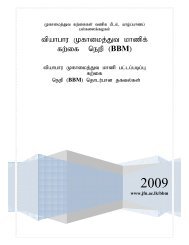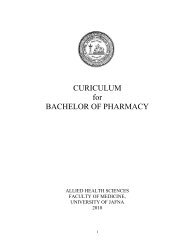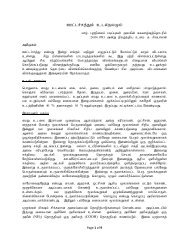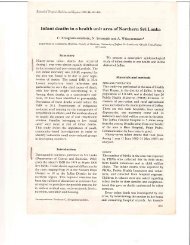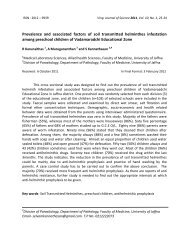MANUAL PHYSIOLOGY PRACTICAL - Repository:The Medical ...
MANUAL PHYSIOLOGY PRACTICAL - Repository:The Medical ...
MANUAL PHYSIOLOGY PRACTICAL - Repository:The Medical ...
You also want an ePaper? Increase the reach of your titles
YUMPU automatically turns print PDFs into web optimized ePapers that Google loves.
FM/UOJ<br />
Experiment M2<br />
MEASUREMENT OF BODY TEMPERATURE<br />
<strong>The</strong> core temperature is maintained around 37°C and shows a slight variation at<br />
certain instances: the diurnal variation, ovulation (in females), and physical exercise.<br />
When it is increased considerably (about 1° or more) the subject is said to have<br />
hyperthermia (pyrexia or fever) and when reduced hypothermia. Accurate measurement<br />
of the temperature is, therefore, very important. <strong>The</strong> surface temperature is usually less<br />
than the core temperature and depends on several physiological and environmental<br />
factors.<br />
<strong>The</strong> core temperature is ideally measured in the oesophagus. For convenience it is<br />
generally measured in the mouth at times it is measured in the rectum or in the axilla.<br />
<strong>The</strong> main aim of the practical is training to record the oral temperature. <strong>The</strong><br />
temperatures of the surface at specific points are also measured to illustrate the variation<br />
in surface temperature.<br />
Instruments:<br />
Clinical thermometer and laboratory thermometer<br />
<strong>The</strong> clinical thermometer is specially made for measurement of oral temperature<br />
the bulb is made of thin glass and the lumen of the shaft is thinner than hair which has a<br />
constriction near the bulb. One surface of the shaft is painted white and the opposite edge<br />
is made into a lens to magnify the mercury column.<br />
Method:<br />
1. Seat the subject comfortably. Take a clinical thermometer, dip it in savlon, wipe it<br />
and wash it in cold water. Hold it tight and shake it so that the level of the<br />
mercury is far below 35°C. Place the thermometer under the tongue of the subject<br />
and ask the subject to keep the mouth closed. Take the thermometer after two<br />
minutes and read the temperature to the accuracy of at least one decimal point.<br />
(<strong>The</strong> mercury column is visible only in one angle and at a certain distance from<br />
the eye because of the lens). Wash the thermometer in the tap water and replace it<br />
in savlon.<br />
2. Keep the bulb of the clinical thermometer in the axilla, cover the bulb with the<br />
arm for two minutes and record the temperature.<br />
3. Keep the thermometer in the cubital fossa and flex the forearm so that the bulb is<br />
fully covered. Keep it for two minutes and record the temperature.<br />
4. Keep the thermometer in the palm and cover the bulb by closing the fingers tightly<br />
for two minutes and record the temperature.<br />
5. Keep the thermometer in popliteal fossa and flex the leg so that the bulb is fully<br />
covered. Keep it for two minutes and record the temperature.<br />
Note: If in any of the above, the temperature happens to be below the measurable level of<br />
the clinical thermometer, and ordinary thermometer could be used. <strong>The</strong>n, it must be<br />
remembered that the temperature should be read while the bulb is in place and not after<br />
removing.<br />
Metabolism & Temperature<br />
Page | 125




